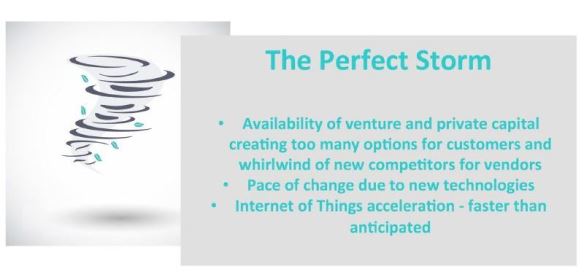Software companies are jumping into action to take advantage of customer spending trends in 2015. Sand Hill’s recent study of software companies for the Software CEO / CFO Outlook 2015 finds the top areas for spending over the next 12 months are (1) initiatives to increase efficiencies and reduce costs, (2) new business initiatives and (3) information security initiatives. The study finds the industry in a period of hyper growth – but with the compounding problem of a perfect storm that produces troubling circumstances in growth opportunities.
The availability of venture and private capital – the first component in the perfect storm – is critical not only because of its impacts on customers and vendors but also because it is a contributing factor to the other two storm components. A common sentiment expressed by several of the study’s participants is that today’s situation is very similar to the dot-com era. As an executive commented, “There is a glut of capital to fund any and all things.” It not only increases the competitive intensity in the marketplace for many vendors but also leads to confusion for software buyers.
The pace of and volume of change because of new technologies and new products leads to buyers of all sizes feeling they must move quickly to stay competitive. But the feeling of haste combined with the pace and the number of options in the market results in several situations. Some of those cited in the report include:
- Less than optimal buying decisions because of confusion as to value with so many options in the market
- Technology implementations not meeting customer expectations for giving them a competitive advantage soon enough
- Large enterprises’ decision processes too slow to keep up with the pace of innovation, so they end up being a year behind the market by the time they implement and roll out new technology
- Vendors trying to deal with customers’ needs, but customers don’t yet really understand their requirements, which causes vendors to take reactive rather than proactive steps
The interviewed executives in the study described how these situations impact their operations. A few examples:
- “The healthcare space is moving very, very quickly; so we’re putting as much investment as we can in our resources so we can move quickly. But we’re doing so while knowing that we don’t have all the answers yet.”
- “Because of the pace of innovation in the market, we’re constantly revisiting and recalibrating our strategy.”
- “We’ve been diving into the mobile space. The pace in that space makes us have to operate more nimbly so we can react quickly to make the necessary decisions and revisions to our product.”
- “Customers in our cloud space want to move quickly. So we scramble for resources to make sure we have the capacity for their demand.”
- “Our sales have grown through the roof. We’re just trying to execute while growing but also need to maintain our culture.”
Accelerated pace in the Internet of Things
Certainly the Internet of Things is a significant factor of the perfect storm contributing to the challenges of growth. As one executive explained:
“We need to be very agile because the IoT’s evolving technologies are coming about in a very big way in the last 12 to 18 months and is having a very significant impact on our short-term strategy.”
In Sand Hill’s industry study in 2014, the majority of participants cited the IoT as having “no impact” or “low impact” on their business. Even most of the early adopters that viewed it as an opportunity said in 2014 that they were not making plans for an IoT initiative on the near horizon, and very few saw it as a competitive threat.
The picture is much different in the 2015 study. Sixty percent of the surveyed companies reported they see real opportunities for new revenue streams from the IoT, and more than half of them said they are actively taking steps to take advantage of those opportunities including:
- Discussing/planning a subsidiary or spinout for IoT business
- Recognizing they need to develop or advance external partnerships to take advantage of the opportunities
Nearly one-fourth (22 percent) of the study participants stated they now view the IoT as more of a competitive threat to their business than they perceived it in 2014, either because of initiatives in 2015 of their existing competitors or because there are new players in their market space that are presenting new value through IoT initiatives.
The report reveals surprises about the impact of two other areas of technology innovation: bitcoin and wearable tech.
Bitcoin trends
Two percent of the participants reported their customers asked them to accept bitcoin or other cryptocurrencies for commerce during 2014 or in the first quarter of 2015. Another 42 percent said their company has talked about the situation and think their customers may ask to use bitcoin as payment in 2015 or 2016.
Wearable tech trends
In the follow-up telephone interviews of some of the online survey participants, we asked whether they were experiencing challenges yet from employees using wearable technologies in the workplace – similar to the way that mobile devices led to new policies and programs to protect businesses that deployed a bring-your-own-device strategy.
Nine percent reported some wearable-tech issues for which they were discussing policies to put in place. Another 18 percent stated they had no issues yet (in March 2015) but believed that situation would change once Apple’s watch hit the market.
Click here to read an excerpt of the report’s contents and buy the report, “Software CEO / CFO Outlook 2015: On the Customer Success Road in a Perfect Storm.”

